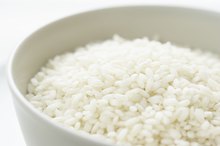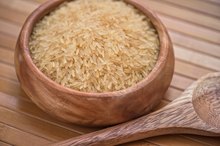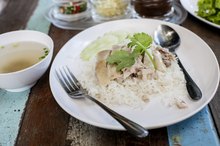Allergy to Rice Milk
People who have a milk allergy are no more likely to have an allergy to rice milk than those with no such problem, because rice milk contains no dairy products 1. Rice milk comes from the rice plant, so if you’re allergic to rice, you can’t drink rice milk. While as many as 25 percent of people believe they have food allergies, only 4 to 8 percent of children and 2 percent of adults actually have a food allergy, according to the University of Maryland Medical Center.
If you are experiencing serious medical symptoms, seek emergency treatment immediately.
Prevalence
Rice allergy occurs more frequently in countries where the general population consumes large amounts of rice, such as Japan, where 10 percent of the natives have a rice allergy, according to gulfMD 1. Rice allergy is rare in the United States 1. If both your parents have food allergies, you have around a 75 percent chance of having food allergies also, but you may not have the same allergies, the University of Maryland states. Unlike many allergies, rice allergy occurs more often in adults than in children 1.
Differentials
Rice Allergy Symptoms
Learn More
Food intolerance can cause indigestion when drinking rice milk if your body has trouble digesting some of the components in rice, but this is not a true allergic reaction. Rice pollen from the rice plant can cause an allergic reaction similar to that people experience with other pollens if inhaled, such as runny nose, sneezing, watery and reddened eyes and difficulty breathing.
Symptoms
Symptoms of rice milk allergy occur within 30 minutes to hours after drinking rice milk and include hives; facial swelling, especially around the eyes and mouth; itching; wheezing; difficulty breathing; throat swelling; lightheadedness; fast heartbeat; nausea; vomiting; stomach cramping; and diarrhea 1. In severe cases, your skin may turn blue from lack of oxygen and you could collapse. Severe allergic reactions, called anaphylaxis, are life-threatening emergencies that require immediate medical attention.
Cross-Reactions
How Much Fiber Is in Rice Bran?
Learn More
If you have an allergic reaction to rice milk, avoid all rice products, including those made from rice flours, found in rice noodles and in spring rolls. Foods in the same family such as:
- corn
- barley
- wheat
- maize
- soybean
- oats
- rye
- triticale may also cause an allergic reaction
People with rice allergy may also suffer reactions to peaches and apples 1. Some people with rice allergies can eat wild rice, but others can’t.
Considerations
You may benefit from seeing an allergist who can do skin testing for allergies to other substances if you have an allergy to rice milk 1. If you have a severe rice allergy, read food labels carefully and carry an epinephrine pen for injection at all times, since rice flour may be hidden in some foods 1. In Japan, where rice is a common allergen, researchers have developed genetically engineered rice that lowers the amount of proteins thought to be responsible for most allergic reactions.
Related Articles
References
- gulfMD: Rice Allergy
- Rice, white, short-grain, enriched, cooked. FoodData Central. U.S. Department of Agriculture. Published April 1, 2019.
- Rice, brown, cooked. FoodData Central. U.S. Department of Agriculture. Published April 1, 2019.
- Roy P, Orikasa T, Okadome H, Nakamura N, Shiina T. Processing conditions, rice properties, health and environment. Int J Environ Res Public Health. 2011;8(6):1957-76. doi:10.3390/ijerph8061957
- Fung KY, Cosgrove L, Lockett T, Head R, Topping DL. A review of the potential mechanisms for the lowering of colorectal oncogenesis by butyrate. Br J Nutr. 2012;108(5):820-31. doi:10.1017/s0007114512001948
- Harris KA, Kris-Etherton PM. Effects of whole grains on coronary heart disease risk. Curr Atheroscler Rep. 2010;12(6):368-76. doi:10.1007/s11883-010-0136-1
- Cermak NM, van Loon LJ. The use of carbohydrates during exercise as an ergogenic aid. Sports Med. 2013;43(11):1139-55. doi:10.1007/s40279-013-0079-0
- Jeon YH, Oh SJ, Yang HJ, Lee SY, Pyun BY. Identification of major rice allergen and their clinical significance in children. Korean J Pediatr. 2011;54(10):414-21. doi:10.3345/kjp.2011.54.10.414
- Nowak-Węgrzyn A, Chehade M, Groetch ME, et al. International consensus guidelines for the diagnosis and management of food protein-induced enterocolitis syndrome: Executive summary-Workgroup Report of the Adverse Reactions to Foods Committee, American Academy of Allergy, Asthma & Immunology. J Allergy Clin Immunol. 2017;139(4):1111-1126.e4. doi:10.1016/j.jaci.2016.12.966
- Qian Y, Chen C, Zhang Q, Li Y, Chen Z, Li M. Concentrations of cadmium, lead, mercury and arsenic in Chinese market milled rice and associated population health risk. Food Control. 2010;21(12):1757-1763. doi:10.1016/j.foodcont.2010.08.005
- Havenaar R. Intestinal health functions of colonic microbial metabolites: a review. Benef Microbes. 2011;2(2):103-14. doi:10.3920/bm2011.0003
- Labensky SR, Hause AM, Martel P. On Cooking: a Textbook of Culinary Fundamentals. Boston: Pearson; 2015.
Writer Bio
A registered nurse with more than 25 years of experience in oncology, labor/delivery, neonatal intensive care, infertility and ophthalmology, Sharon Perkins has also coauthored and edited numerous health books for the Wiley "Dummies" series. Perkins also has extensive experience working in home health with medically fragile pediatric patients.









